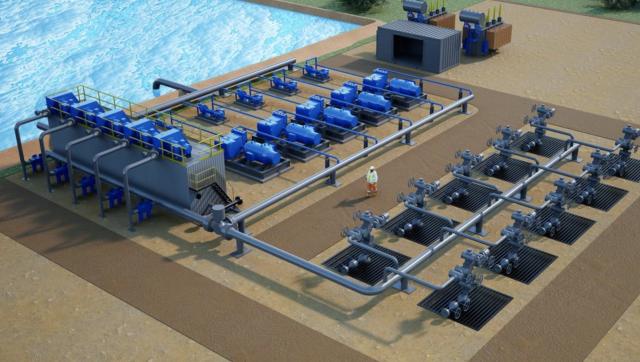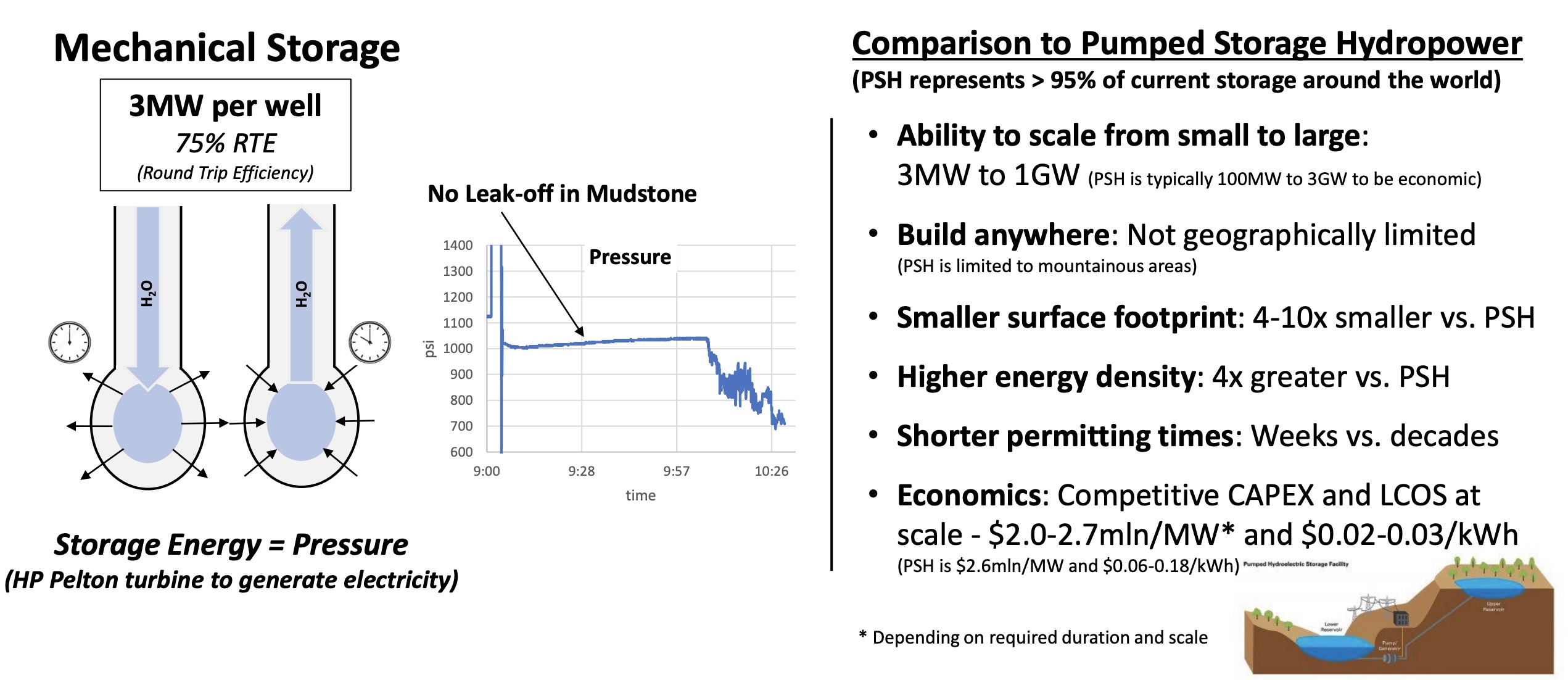
A scale rendering of Sage Geosystems’ 30-MW energy storage system. (Source: Sage Geosystems)
Fluctuating weather patterns mean solar and wind energy are not always aligned with peak energy demand hours, leading to output curtailment from excess electricity production when consumers need it the least.
However, a Houston-based startup called Sage Geosystems is on a mission to make electricity available whenever it’s needed, regardless of whether the wind is blowing or the sun is shining. Using proven oil and gas technologies along with geothermal baseload expertise, Sage Geosystems says its energy storage technology is ready to scale after results of a commercial pilot show its cost-competitiveness and efficiency.
“We can deliver either long duration or short duration load-following energy storage. …We can do it now and we can do it cost competitively with the energy storage solutions that are already out there, like pumped hydro or lithium-ion batteries,” Sage Geosystems CEO Cindy Taff told Hart Energy. “To me, that is going to revolutionize how the grid looks at storage.”
Called EarthStore, the mechanical energy storage technology harvests the pressure energy of fluid pumped and stored underground, enhanced by heat from the formation. When supply exceeds demand, it buys the electricity to power pumps and inject water, which is stored underground. When grid demand peaks, the well can be opened to allow water to be produced from fractures at great force, sending water flowing through turbines to produce electricity, Sage explains.
“The challenge that the utility grid has right now is that it needs storage to help move energy from a time of day or even time of week from where the demand is low to where the demand is high,” Taff said.
Parts of the U.S. have endured a scorching summer this year, with record-setting high temperatures straining electric grids and prompting energy conservation requests from grid operators, including by Texas’ ERCOT. While natural gas continues to dominate the fuel mix for current generation in Texas with help mostly from coal, solar and nuclear, power storage is expected to play a key role in making ends meet during challenging times.
Sage Geosystems says its technologies demonstrate both short- and long-duration energy storage, meaning its discharge times range from hours to seasons.
The Sage team, including its chief, brings several decades worth of oil and gas experience to the geothermal sector. Taff, a former vice president of unconventional wells and logistics for Shell, said Sage reentered one of Shell’s old gas exploration wells in Starr County, Texas, for the pilot.
Testing the tech
In 2021, Sage tested and proved technologies that create artificial reservoirs or tanks in a formation with fractures, which operate similar to a balloon. In February 2023, the team began the commercial pilot of its mechanical energy storage technology. For five weeks, a series of pumping and flowback occurred.
“We were pumping large volumes of water into the fracture and then flowing that back over time so that we can measure the flow rate and the pressure,” Taff explained. “From the flow rate and pressure, you can determine the power output. We were using oil and gas equipment on the surface to control the flow rate. We were also using oil and gas equipment to actually measure the pressure and the flow rates in that test.”
The Shell exploration well had been drilled to nearly 20,000 ft in 2008, but cased to only 11,500 ft. Sage’s pilot reached depths between 8,000 ft and 9,500 ft, Taff explained, with a temperature of about 250 F—not quite hot enough for geothermal but warm enough to expand water and boost the system’s overall efficiency.
With a casing size of about 9 and 5/8th, the volume of water pumped was usually about 20,000 bbl, she said; however, smaller volumes were also pumped to “demonstrate the duration of the storage was in direct proportion to the volume of water that you put in the pressure.”
Results released Sept. 12 revealed the energy storage technology:
- Produced 200 kW for more than 18 hours (long-duration) and 1 MW for 30 minutes (load-following), limited by only rental surface equipment piping;
“We were pumping in 4 to 6 hours and then producing for 18 [hours]. If you think about combining that with solar, you can make solar 24/7. We can basically revolutionize the energy grid by making solar and wind 24/7 baseload,” Taff said.
- Generated electricity with Pelton turbines to power equipment on location;
- Recorded measured subsurface system efficiencies between 88% and 94% with estimated round-trip efficiency of 70%-75%, which Taff said are comparable to other energy storage solutions such as lithium-ion batteries; and
- The process also produced waste heat, which could be used for industrial purposes.
An unexpected result turned up in how the fracture acted. A single, vertical well was drilled with a simple planar fracture using gravity fracking technology.
“The pleasant surprise was we thought we would have to basically place multiple fracs in a well to get the amount of power that we got out of the single fracture in this one vertical well,” Taff said.

Ready to scale
The pilot demonstrated a single well could generate 2 MW-3 MW net storage, Sage said, with the levelized cost of storage (LCOS) cost-competitive with pumped storage hydropower and lithium-ion batteries.
“What we’re doing is exactly like pumped hydro, except instead of going up a mountain, we’re doing it deep in a well. We’re using oil and gas technologies to do pumped hydro storage deep in a well with a smaller footprint, cheaper,” Taff said. “We can do it quicker because you don’t take decades to get permits. Pumped storage hydro LCOS is between 6 cents and 18 cents a kilowatt hour. Whereas, again, we’re in the 4 cents per kilowatt hour range.”
The technology can be interconnected with power grids or used to develop island or microgrids, she said.
Next steps for the technology include a demonstration at a power plant. The project will initially include a single well generating 2 MW-3 MW.
“But what we want to do is drill it in an area where we can use multi-well pad drilling to then scale to 50 megawatts,” Taff said, in terms of scaling up to 20 wells.
Sites being considered are in Texas and Louisiana.
Sage said it is currently in energy storage discussions with two oil and gas producers, one in the U.S. and another in the Middle East, and with solar and wind providers.
Nabors is among Sage’s investors. In 2021, the drilling company announced it had invested $10 million in Sage.
“We believe Sage’s novel approach to harnessing geothermal energy has significant potential to be disruptive to energy markets worldwide,” Nabors CEO Anthony G. Petrello said at the time.
Though the paths of geothermal and oil and gas, which both utilize drilling, rarely—if ever—crossed in the past, the two are coming together.
“The oil and gas industry has a lot to give to this technology, whether it’s energy storage or the new geothermal technologies,” Taff said. Leveraging the oil and gas industry to help drive down the cost, she said, is crucial to making this work.
Recommended Reading
New Fortress Energy Sells Two Power Plants to Puerto Rico
2024-03-18 - New Fortress Energy sold two power plants to the Puerto Rico Electric Power Authority to provide cleaner and lower cost energy to the island.
Tellurian Reports Driftwood LNG Progress Amid Low NatGas Production
2024-05-02 - Tellurian’s Driftwood LNG received an extension through 2029 with authorization from the Federal Energy Regulatory Commission and the U.S. Army Corps of Engineers.
Vision RNG Expands Leadership Team
2024-05-01 - Vision RNG named Adam Beck as vice president of project execution, Doug Prechter as vice president of finance and Beckie Dille as HR manager.
JMR Services, A-Plus P&A to Merge Companies
2024-03-05 - The combined organization will operate under JMR Services and aims to become the largest pure-play plug and abandonment company in the nation.
Tellurian Executive Chairman ‘Encouraged’ by Progress
2024-03-18 - Tellurian announced new personnel assignments as the company continues to recover from a turbulent 2023.






